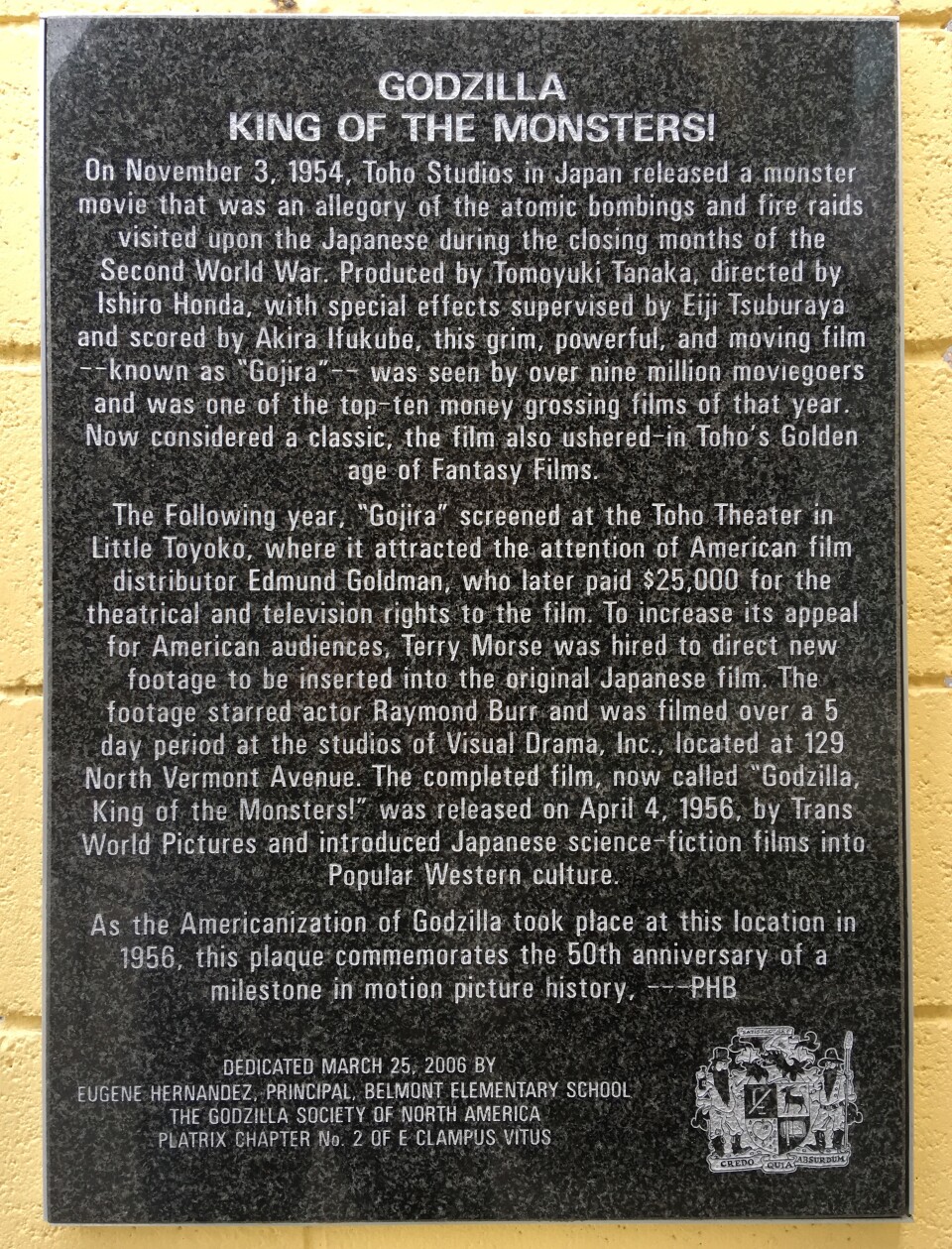Truth matters. Community matters. Your support makes both possible. LAist is one of the few places where news remains independent and free from political and corporate influence. Stand up for truth and for LAist. Make your year-end tax-deductible gift now.
The little-known connection between LA and Japanese monster masterpiece, 'Godzilla'

Today marks a very special day for a timeless Japanese icon.
On Nov. 3, 1954, the first Godzilla film was released in Japan. The monster flick, which many people saw as an allegory for the Atomic bomb, was a box office hit in the country, and would go on to become a global sensation.
But, "unbeknownst to many people, Godzilla's international stardom actually began right here in Los Angeles," said Steve Ryfle, who co-authored the book, Ishiro Honda: A Life in Film, from Godzilla to Kurosawa.
That's because for five decades, according to Ryfle, pretty much the only way audiences in the U.S. and other parts of the Western world could see the film was through a highly altered version of the 1954 Japanese original.

The Los Angeles connection
And that re-edited version, titled Godzilla King of the Monsters! contained added scenes that were all shot in Los Angeles.
"It was a Japanese production, produced for Japanese audiences. It was made for an audience that had only nine years prior experienced the end of the war and the surrender," Ryfle said, referring to the Hiroshima and Nagasaki bombings that brought an end to World War II. "Even though it was entertainment film, a monster film, it was very much about the Japanese experience during and after the war."
Ryfle said audiences outside of Japan might not necessarily connect with the material the same way. Also, he added, the film was entirely in Japanese.
"In that day and age, you really wouldn't have been able to dub a film or even subtitle it and show it to a mass audience," Ryfle said.
How the film landed in L.A.
The studio behind Godzilla — the renowned Toho Studios — was looking to expand into foreign markets, and set up a small export office in L.A.
One of the films they offered up for sale was the monster film, said Ryfle. The people who bought it were not your typical Hollywood execs.
"If you've ever seen the movie Ed Wood, set in this kind of B-movie world of the 1950s where people were making films fast and cheap and about really exploitative types of subjects — that's the type of people who purchased Godzilla and tried to turn it into an American monster movie," Ryfle said.

What these American producers did to the original Japanese version was write in an entirely new character named Steve Martin, who is an American wire service reporter stationed in Japan, played by character actor Raymond Burr of Perry Mason fame.
How the sausage was made
"They more or less heavily re-edited new scenes starring Burr into this drama and made him more as a narrator than a protagonist," Ryfle said.
Those scenes were shot around 1955 at a little studio, now defunct, called Visual Drama. Legend has it that all the Burr additions were filmed in a marathon 24-hour session.
"They hired Asian actors, they shot scenes where Burr appeared to be interacting with the Japanese cast, and they used similar clothing, and they kind of used reverse angles and intercut Burr into the scenes of the Japanese film," Ryfle said.
U.S. debut of "Godzilla: King of the Monsters!"

Godzilla: King of the Monsters! opened in American theaters in April 1956 — about a year and a half after the original film was released in Japan. And it was a big hit for a black-and-white independently released low-budget film, according to Ryfle.
That same altered version would expand its fandom on American syndicated television. But it wasn't until 2004, on the 50th anniversary of the release of the first Godzilla, that the Japanese original was officially released in the United States for the first time.
By then Godzilla: King of the Monsters! had become so beloved and seminal in its own rights that the film is now part of the lauded Criterion Collection.
About that little film studio...
The little dingy studio in Koreatown where those Raymond Burr scenes were shot is now an elementary school.
There's a bronze plague staking its claims in Godzilla history, after a group of fans, including The Godzilla Society of North America, and local historians raised money for a commemorative marker in 2006.
"I thought that was a really nice way of denoting this little piece of misunderstood and even unknown Hollywood history," said Ryfle. "To this day, you still have this misunderstanding among a lot of people who are misled into believing that this is the original version of the film."
"Godzilla" anniversary events
Ryfle and his co-author Ed Godziszewski will be on hand for these events celebrating the 70th anniversary of the release of the original Godzilla.
- Godzilla-Thon! Movie Marathon
An all-day marathon of 5 Godzilla films
When: Nov. 3, Sunday, starting from 11:00 a.m.
Where: David Geffen Theater at the Academy Museum of Motion Pictures, LACMA West, 6067 Wilshire Blvd, Los Angeles - Godzilla and the Art of Japanese Special Effects
A lecture and discussion
When: Nov. 4, Monday, 7:00 to 8:30 p.m.
Where: The Japan Foundation, 5700 Wilshire Blvd Suite 100, Los Angeles
Event is free; registration is required












